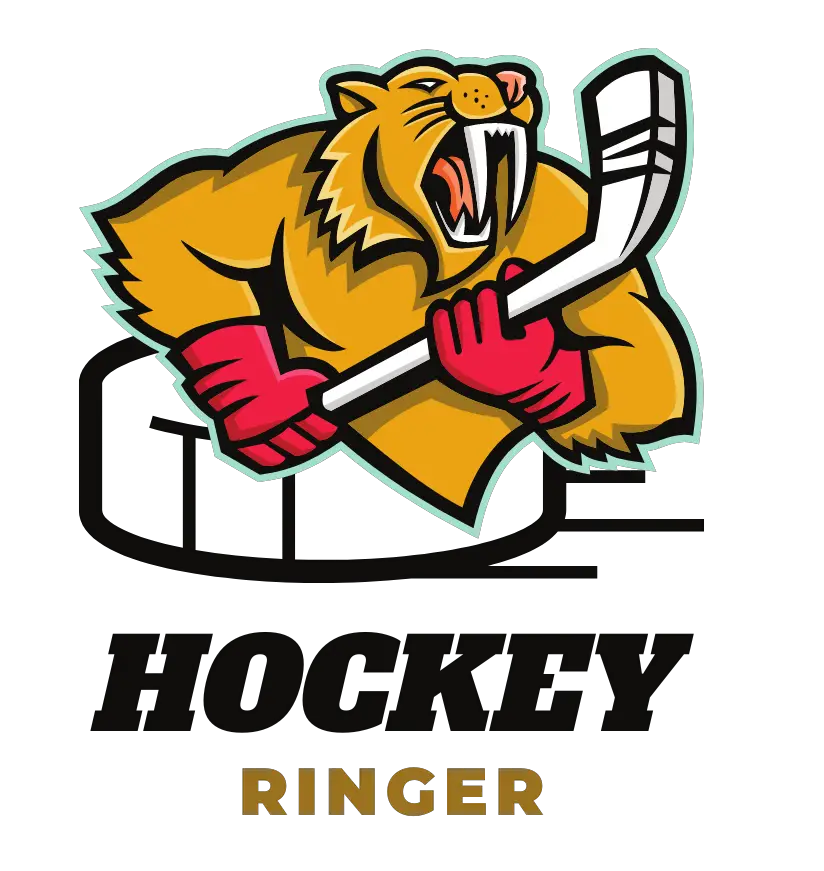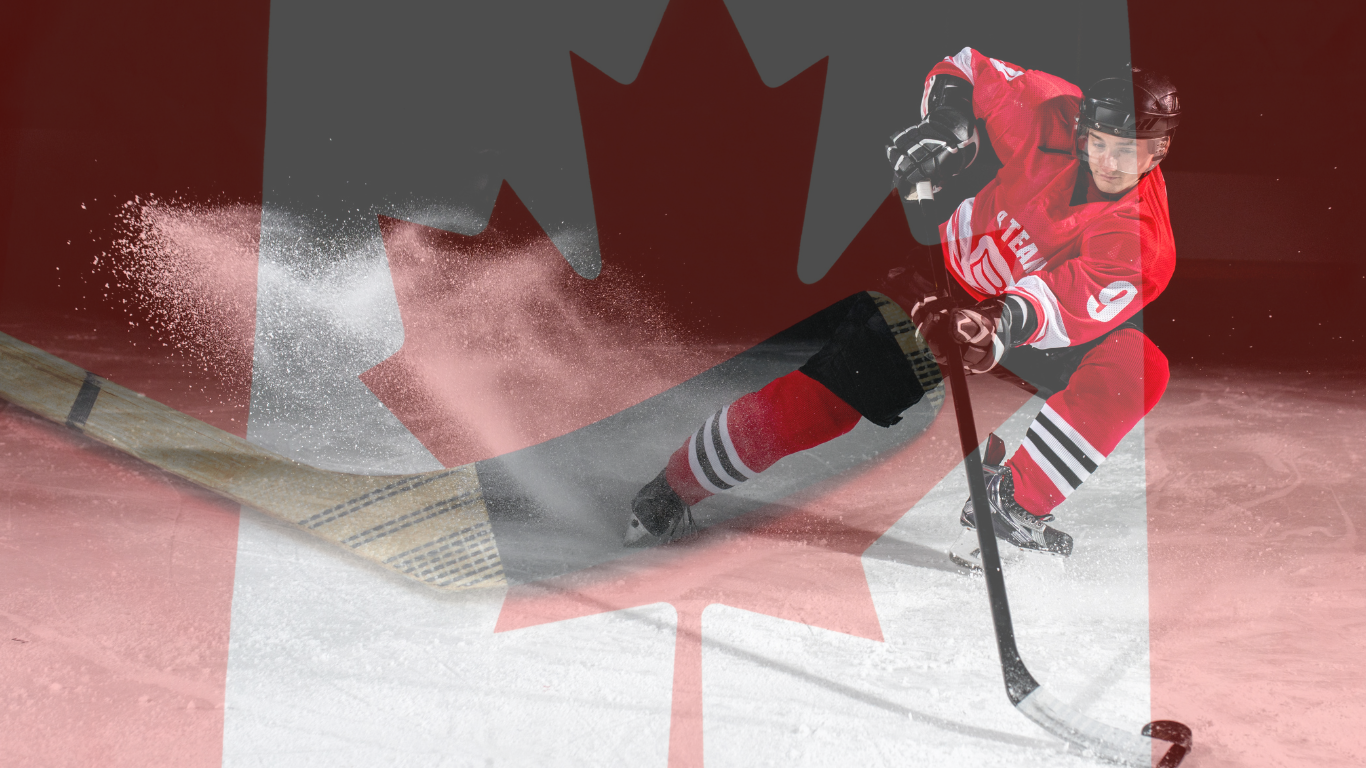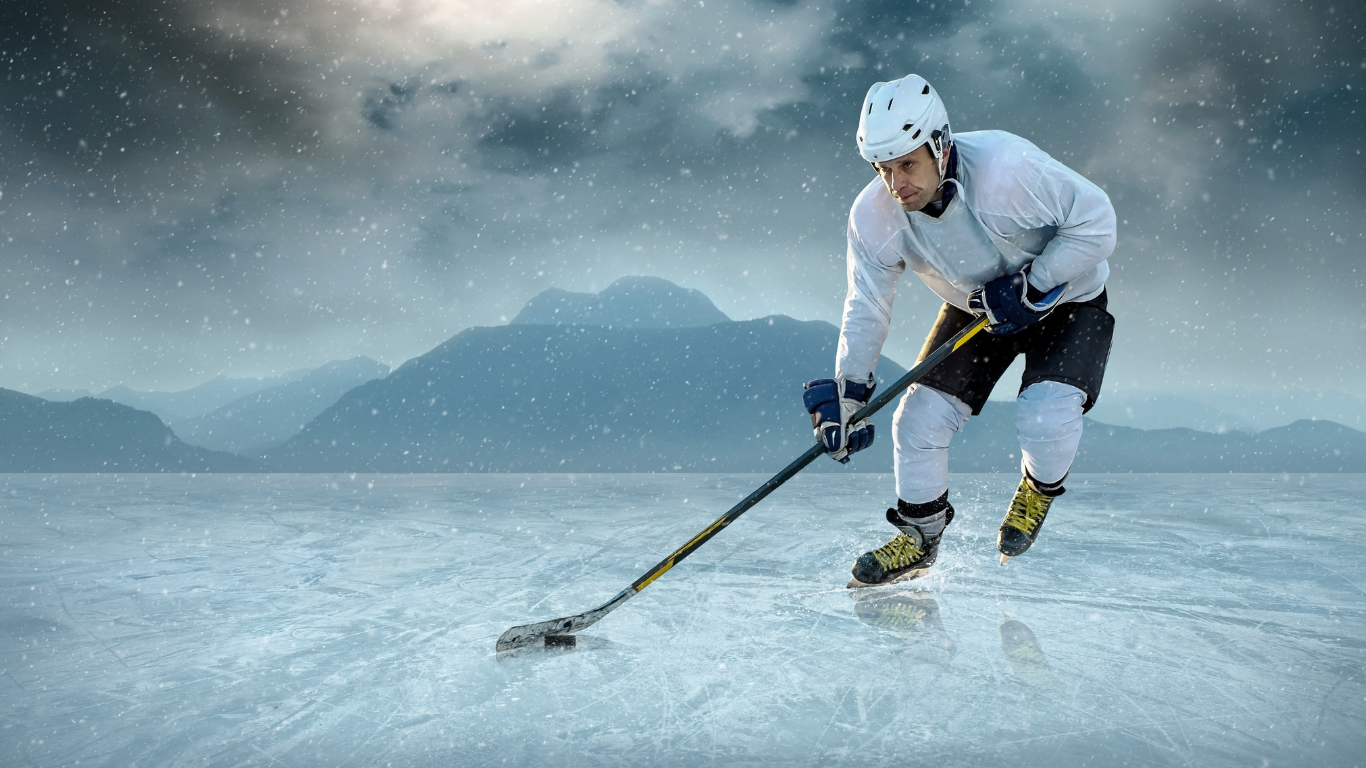When you’re attending an ice hockey game and you’re not really sure how cold it will be and what you’ll need to wear, we’ve got all the answers for you here. No doubt you already know that the temperature in the building needs to be low enough to keep the ice from melting. But how cold is it for fans really?
At a professional NHL hockey game, the temperature in the arena ranges between 60F (15C) and 65F (18C).
So it’s basically mildly colder than room temperature and quite colder as you get closer to the ice. You can get away with wearing several light layers, a sweater, or a hockey jersey. That’ll keep you warm and comfortable during the 2.5-hour game.
At recreational rinks, however, it can be much colder than at a professional venue. With temperatures ranging around 55F (12C) or even lower than that, you’ll have to wear a warm jacket, gloves, and other heavier clothing options.
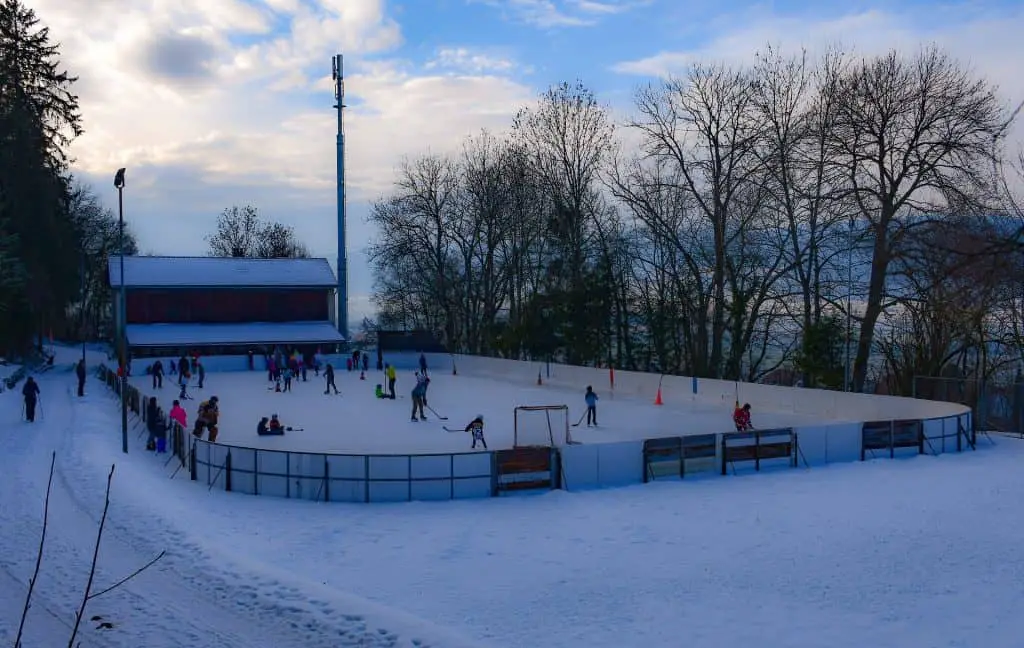
How Cold Is It at Professional Hockey Games?
For professional hockey venues, the NHL-recommended temperature is 60F (15C) at the beginning and keep it up to 65F (18C) as the game advances.
NHL recommends keeping the ice at a temperature between 19 and 21 F, to keep it well frozen. The low ambient temperature improves ice conditions which in turn makes it easier for the ice hockey players to keep moving at a fast pace during the game.
As more people come into the venue, the temperature inside the building will naturally increase causing a rise in temperature of the ice. In that case, to keep the ice from increasing above 24 degrees and becoming softer, the ice technicians will use an HVAC system to control the overall temperature and keep the venue cool.
Now, pertaining to the fans that come to see the hockey game, they should know that there are two factors that influence the temperature of the avenue and subsequently their own comfort.
- First, you should take seat location into consideration as it plays an important role in how comfortable you’ll be during the game. The closer you are to the ice, the cooler it’ll be as you’re exposed to the cold air over the rink.
Also, the lower level is chiller than the upper one — knowing that the heat rises and the cold sinks.
However, if you’re sitting at the back seats it can feel quite warmer there as the warm bodies of other people around you will come between you and the mass of cool air in the center of the arena.
You may also find random spots way up in the nose bleeds where it’ll feel much colder as you’re exposed to the air conditioning vents.
- Secondly, as also mentioned above, attendance also plays a major role in affecting the temperature of the building. The more people attend the game the more the temperature will rise. That’s when the staff at the venue will have to pump up the air conditioner to keep the cool air stable.
Imagine arriving early at the ice hockey arena and there are only the staff and the team members and organizers. Now imagine the whole arena packed with 18,000 people — which is the average attendance for a hockey game — and you can definitely tell the difference between the two scenarios.
The warm human bodies and the players sweating throughout the whole game will cause the overall temperature to rise up to around 65F.
What Should I Wear To a Professional Hockey Game?
When you’re considering what to wear at a hockey game, you’ll probably want to wear your favorite hockey merch, such as your favorite player’s jersey or a team hat, but you also want to keep yourself warm and comfortable.
In general, during a professional NHL game, if you wear a hockey sweater or a light jacket over your casual clothes, that’ll be quite enough.
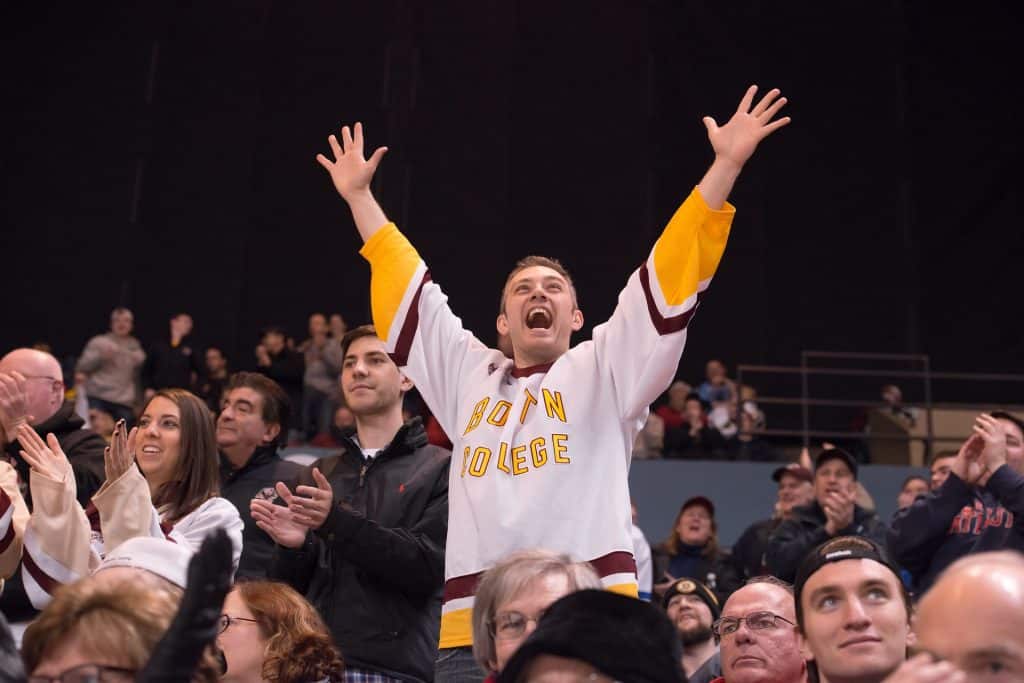
If you’re still worried that your outfit won’t keep you warm enough because you get easily cold, and you’re not sure if your jersey will be enough to get you through the whole game, consider wearing more layers. That is always a good and safe idea.
So basically you can wear a t-shirt, then a comfortable long-sleeve shirt and your hockey jersey on top.
You can also take along with you a warm hoodie or a lightweight jacket, whichever you prefer. In case you feel warmer than comfortable you can always remove a layer or two.
But in any case, you can wear your favorite hockey jersey on top to support your beloved team and feel a powerful sense of unity and belonging with the other fans.
At a professional hockey venue, there is definitely no need to wear heavy coats, gloves, or a ski toque. Unless you love your ski toque and can’t possibly imagine ever leaving the house without it.
Heavier clothing options are mostly required at recreational hockey games which are played outside.
What About Temperatures At Recreational Hockey Arenas And What Should I Wear?
If you are attending a recreational hockey arena to proudly watch your kids playing their first hockey game, then it’s generally a safer option to wear a couple of shirts beneath your warm jacket. It’s also highly suggested that you wear a scarf or hat, and mittens. You can even wear your winter coat.
Since temperatures at such venues range around 55F (12C), they are in general much chiller than a professional arena so you may want to wear more layers beneath your coat.
Also, keep in mind that loose pants will keep you warmer than skinny jeans do, so you’ll want to opt-in for the warmer option. There are also wool socks and winter boots that you can wear to stay warm and comfortable during the game.
Some people even take blankets along with them, either to put between them and the cold metal bench or to keep on their lap.
Since many recreational hockey rinks are outside, you can also bring a hot seat along with you to keep your bottom warm, especially if there’s metal seating.
Always keep in mind that those venues are quite cold and having to sit for more than a couple hours to watch a game, you’ll have to keep your body temperature high. Remember that for outside games, the temperature doesn’t rise with attendance. It might even feel much colder towards the end of the game, as inactivity can drop your temperature even more.
It’s safer to wear heavier clothing to keep warm rather than be lightly dressed and having to sit through the whole game freezing.
By wearing warm clothes and even taking with you a thermos with warm tea or coffee will help you keep your temperature from dropping.
You can also check if the hockey arenas have overhead heaters installed in the stands. They can keep the spectators warm, raising the temperature 5 to 10 degrees higher, which makes the watching experience more comfortable.
How Long Does a Hockey Game Last?
Ice hockey games last about 2 and a half hours. NHL professional games have 3 periods, each lasting 20 minutes, plus two intermissions, each 18 minutes long.
So the actual playing time is 1 hour. And the clock only runs while the puck is in play.
If the game is tied, then there is overtime which can go on for five minutes give or take. Shoot- outs can go on indefinitely.
Basically, the average hockey game can go on for about 2.5 hours. So if your game starts at 9:00, it should be over at around 11:30. And if the game is tied at the end of regulation it can go on a bit longer.
High school games though can be shorter, as there are 15 minutes intermissions.
In either case, if your hockey outfit is warm enough, it can easily keep you comfortable throughout the 2 and a half-hour game.
What Time Should I Arrive At The Hockey Game?
Some fans prefer to arrive at the game before the puck drops, so 30 minutes earlier, give or take. That’ll give you plenty of time to find your seats, maybe even purchase some attire from the souvenir shop and settle in.
Once you get there, the empty arena will feel quite chill, but once it’s packed with 18000 fans getting all excited and jumpy about the game, the air will feel warmer as the game progresses.
The national anthem gets played 15 minutes before the game, and it gives fans a great feeling of excitement as the game is about to start.
Can I Buy Hot Beverages At Ice Hockey Arenas?
Professional hockey arenas do have options for drinks and food that you can buy, whereas recreational venues have a concession with a small variety of options like hot chocolate, coffee, and a few more snacks.
Usually, at recreational venues, prices of food and drinks are more affordable than at the professional NHL games.
If you find the prices too high, you can always attend a pre-game or a post-game dinner and get better food options and still spend less than what you would inside the hockey venue.
Still, if you don’t have time for that, you don’t have to worry about getting hungry or thirsty during the game. You’ll always find something to satisfy your needs, even if the price can sting a little.
